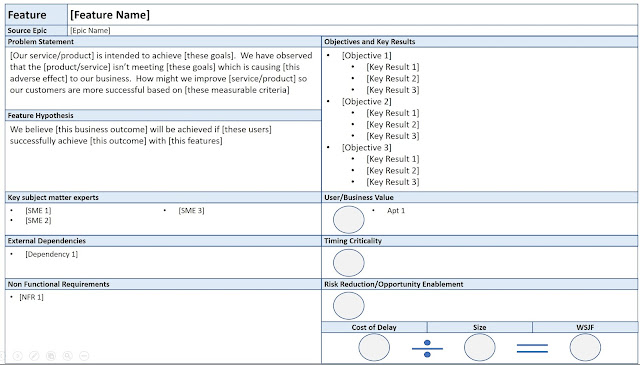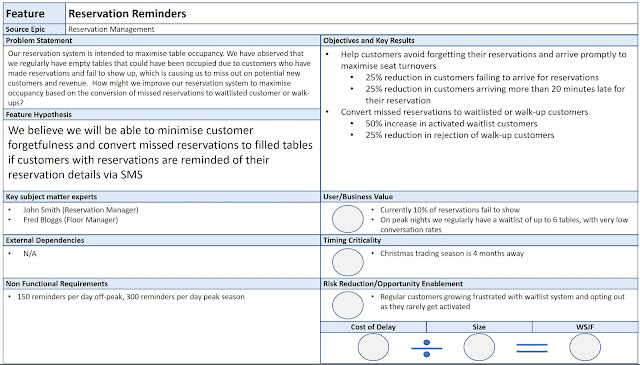At some point it dawned on me. If you consider the size of investment involved in running an Agile Release Train, under any legacy delivery model there would have been some form of executive steering committee. Through this lens, you are offering the ART Business Owner construct as a Lean|Agile alternative to the traditional steering committee.
I have been rewarded by deliberate focus on formalizing the Business Owner construct. It has unlocked one of the key decentralization puzzles I have encountered in my years with SAFe. At some point in the journey of envisioning an ART, you are looking for a Product Manager. A single person with a huge amount of delegated responsibility as the strategic voice of the customer. Finding that one person the enterprise agrees can effectively represent all the competing interests for the ART's strategy and capacity can be almost impossible. The problem also rears its head for the Release Train Engineer (RTE). Most ARTs will be working on multiple strategic assets with a diverse ownership throughout the IT organisation - owners who often have significant concerns about others working on their platforms.
I have come to think of the RTE and Product Manager as empowered delegates of the Business Owners for the ART. The Business Owners are then collectively accountable for rapid response to any decision escalated to them. When these 2 layers of leadership operate effectively together, magic happens.
When and How to select Business Owners
The journey of an ART begins with leadership training and a vision workshop. We are looking for a group of leaders and stakeholders collectively aligned in their understanding of the framework and with a shared vision for what the ART will be.It is ideal for Business Owners to be a part of this early journey, so the time to map candidate business owners is when you're determining the attendees for the Leading SAFe and the vision workshop.
When selecting business owner candidates, an overall stakeholder map can be a useful input. You need 2 types of representative:
- Business Stakeholders
- The owners of the operational value stream(s) the ART will service
- Stakeholders with policy, regulatory or other assurance concerns in relation to the ART's mission
- Owners of funding (if not covered above)
- Technology Stakeholders
- Designated owners of Strategic Technology Assets the ART will impact
- Line Managers of staff the ART is likely to recruit
What level executive?
If you look too junior for your Business Owners, they won't have the teeth to fulfil their mission. Conversely, looking too senior will give you authority but is unlikely to yield the time commitments you will be pursuing.Whilst most organisations have their own leadership hierarchy, I find the sweet spot in large organisations is "the most junior level still considered to be an executive" - just above the line where senior middle management begins. Considering this to be a "level one exec", I take one extra step - find the level 2 exec in that area and seek a nominated delegate.
How many do I want?
There is no set answer to how many Business Owners an ART should have, but I have some rules of thumb based on experience. A number of times two were nominated - the Business Sponsor and the Technology Owner. These struggled, partially due to a lack of diversity of voice and nearly always because the Business Sponsor had numerous peers who had interests they did not feel the sponsor adequately represented.So, I worry if I see less than 4 Business Owners. On the other hand, too many is also a huge problem. It's incredibly difficult to reach and maintain alignment and move on critical decisions with a large and unfocused group. I once had the misfortune of trying to facilitate an ART vision workshop with 30 candidate Business Owners and convergence was near impossible.
You want enough to be appropriately representative (usually at least 4) and not so many you'll struggle to make decisions (usually painful to move beyond 8-10).
The importance of setting expectations
Your prospective executive business owners need to understand what comes with the job. As a collective the organisation is making them accountable for fiscal oversight and executive championing of the ART's mission.They will attend and actively participate in a number of SAFe events, with a not inconsiderable accompanying time investment. They will be needed for at least the following:
- Participation in the ART vision workshop
- Participation in the Program Backlog prioritisation workshop(s) each PI
- Attendance at PI planning, validation and acceptance of objectives and participation in the management review
- Attendance at System Demos (as part of their oversight obligations)
- Attendance at and participation in Inspect and Adapt
- Periodic participation in governance and escalation workshops with respect to ART performance.
- Being the 'voice of the ART' in their area of the business.
They will need to understand the purpose of each of these, their role, and the ensuing time commitments.
I believe the position of Business Owner on an ART should be formally nominated and accepted, and would go so far as to suggest formalising a Terms of Reference for the Business Owner committee.
Leveraging your Business Owners
The primary times your train and Business Owners will intersect will be through the afore-mentioned SAFe events. Following are some of the patterns I have found beneficial.The ART Vision Workshop
Every ART should start with a clear vision, and this is the workshop that first crystalizes it (documented here). Agreement is reached on Customers, Success Measures, Vision Statements and the nature of the solution to be built and the business owner roles are confirmed. As the executive owners of the ART, it is critical not only that the business owners have a voice in shaping the vision but that clarity and alignment is reached on how the ART's success will be measured.Program Backlog Prioritisation Workshops
In preparation for this workshop, the Product Manager has been decomposing Epics, talking to customers, and reflecting on learning from shipped features to identify and shape a set of candidate features to add to the Program Backlog. Each feature has a value proposition, and in SAFe we use a contextualised Cost of Delay (COD) estimation and the Weighted Shortest Job First algorhythm to arrive at economic priorities.In this workshop, new features are evaluated to determine their COD and existing backlog features where conditions might have changed are re-assessed. Based on known information about feature value proposition, Business Owners use agile estimation to come into alignment on the cost of delay. This enables the Product Manager to fulfil their responsibility to maintain an economically prioritised backlog whilst leveraging the diversity and organisational authority of the business owners to make the assessments.
PI Planning
Little needs to be added to existing material in this space. Business Owners have a critical role to play both interacting with teams on an adhoc basis and in a planned fashion through plan reviews and the management review. The PI Planning event provides amazing "Gemba time" for executives, with much to be learned by observing and interacting as the teams build their plans.The event commences with a set of priorities that have been validated and endorsed by the business owners. By the end of day 1, there will be various challenges to that vision. Regularly, hard decisions will need to be made, and made on the night. Management Review provides the forum to revisit their earlier "value proposition discussion" in the light of emerging information and provide rapid response with the same set of authority as drove the initial priorities.
On the second day, the all-important "Business Owner walk-around" occurs. The Business Owners visit each team and conduct a review and assessment of the PI objectives. It both establishes direct executive/team engagement and feedback, and permits clarification of objective intent - maximising the chance both the team and their stakeholders leave the room aligned in their commitment expectations.
System Demo
The primary "Execution reporting" vehicle for the ART culturally is the System Demo. Every 2 weeks, it provides a transparent checkpoint based on demonstrated functionality and linkage back to PI objectives. It also acts as a platform for feedback. As implementations are demonstrated, where they differ from the vision of the business owner or expose new challenges or insights this is the forum to both trigger and receive that feedback.Inspect and Adapt
Business Owners have a role to play in all 3 phases of the Inspect and Adapt workshop. During the PI Demo, they are gaining an understanding of "what has been achieved" in the PI with reference back to the objectives committed at PI Planning. During the quantitative measurement phase, they are both reviewing ART PI Metrics and evaluating performance of teams against their committed objectives based on the Demo.Finally, during the problem solving workshop they provide the all-important executive lens to root cause analysis and brainstorming. It provides them with invaluable time "at the Gemba", and insights into enabling initiatives that should be prioritised.
Governance
Each of the SAFe events described above qualifies as a governance event. Collectively, they enable the Business Owners to steer ART strategy, provide rapid decision-making response at key moments in the lifecycle and maintain visibility through System Demos and Inspect and Adapt.However, it is also typical to establish some form of cadence-based "ART Steering" forum. In previous versions of SAFe this was known as "Release Management", but I suspect it has receded from visibility in the framework due to confusion over the title. A monitoring and escalation forum needs to exist for the ART during PI execution. It is informed by the standard SAFe events, but facilitates monitoring and follow-through of the various risks and issues that emerge.


